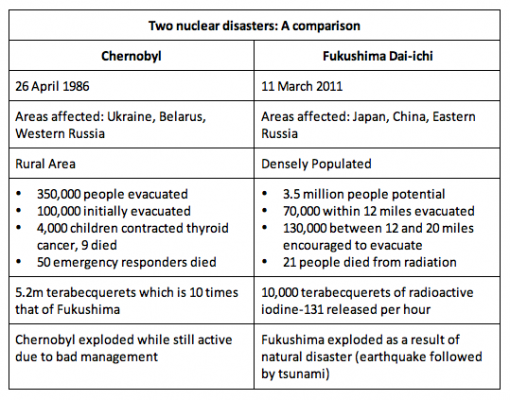Nuclear Crises Then and Now
The Fukushima nuclear crisis in Japan triggers memories for a young man whose father was, along with thousands of other Ukrainian workers, sent by the Soviet government to help clean up after the Chernobyl meltdown in 1986.

I barely have the energy to type. This flu is overpowering. I am weak in the joints and a pounding headache makes me feel like it’s the end of the world.
We’ve all been there in the depths of a debilitating flu. Now just imagine a life where this feeling is infinitely magnified and you know you can only get worse with time. That’s what happens with radiation sickness. You sink into depression; all you can hope for is a quick death.
“Depressed and miserable” is how my father described the people of Chernobyl when he was among the thousands of local men summoned to work on the clean-up and the relocation of the local inhabitants out of the frozen zone.
I was only three when the nuclear reactor meltdown occurred in what was then the Soviet Union. My recollection of the aftermath is hazy, but what is clear is that the consequences lasted for years to come.
A minor consequence, when my family moved to the U.S., was the “glow in the dark” jokes that high school kids cruelly made about us Ukrainians. The real tragedy lay in the radiation effects on humans and animals, and the declaration by the authorities of a vast area of land as unliveable.
As a truck driver, my father worked for several weeks in the 30km radius from ground zero. This area was later found unsafe because of heavy radiation and the exclusion zone was extended to a 50km radius.
A few of my father’s colleagues, some of whom are still alive today, were given the task of welding a dome structure over the accident site which was later filled in with concrete to seal the area. These men had little choice in the matter. The government said go, with little explanation of what they were dealing with or what the consequences could be, and all the men could do was to go.
There were some instances of double-headed cows or dual-torso pigs being born.
The saddest part of the Chernobyl meltdown was the Soviet Union’s handling of it. The population had no idea what had happened for more than a week after the accident. My mom speculated that perhaps the only reason an announcement was finally made was because of the precipitation on Labour Day, which was celebrated in all major cities in the U.S.S.R. with big parades to show off the Union’s military might. Many people were exposed to high levels of radiation due to this rain.
The impact of Chernobyl was considerable. There were some instances of double-headed cows or dual-torso pigs being born. Many people in the area were exposed to low-level radiation for an extended period of time. My mother still talks of how my sister, who celebrated her first birthday just two days before the disaster, lost her hair. With no modern medical advice available, my mother used traditional medicine to treat this.
Today Chernobyl is still a ghost town. But the current government is looking to capitalise on the newly realised tourist opportunities, as well as solicit a global commitment to the environmental clean-up effort that is still necessary for the affected area.
Watching the Fukushima nuclear crisis unfold, I felt a distinct sense of déjà-vu. I wouldn’t have imagined in my wildest dreams that such a tragedy could strike twice. Surely the world would have learned some lessons from Chernobyl.
One important difference today is that technological advances and the enormous reach of social media ensure that news spreads regardless of the authorities. This will, hopefully, result in better handling by governments when disasters occur, whether due to mismanagement as at Chernobyl or to natural causes as at Fukushima.
The writer was born in the Soviet Union in 1982, grew up in Ukraine, and then studied in the United States. Currently on a six-month work and holiday visit to Singapore after a year in Australia on a similar programme, he is addicted to travel, good food and all things automotive.


















